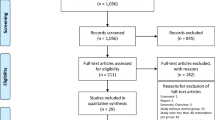Abstract
AIM: To appraise quantitatively current evidence regarding the caries-preventing effect of resin-modified glass-ionomer cement (RM-GIC) fissure sealants in comparison to that of resin-based fissure sealants. STUDY DESIGN: Systematic review with meta-analysis. METHODS: 8 Anglophone databases and 2 Lusophone databases were searched until 15 April 2009, using a pre-determined search strategy. Clinical trials were considered for inclusion if their titles/abstracts were relevant to the topic, published in English, Portuguese or Spanish and had a two-arm longitudinal study design. The outcome measure of the caries-preventive effect was caries absence on sealed teeth. Two reviewers independently extracted data from the accepted articles in order to complete a 2×2 table for meta-analysis. The unit of interest was the tooth, and the number of caries-free teeth (n) at the end of each time interval (6, 12 and 24 months) was compared against the total number of evaluated teeth (N) STATISTICS: Datasets were assessed for their clinical and methodological heterogeneity, following Cochrane guidelines, and only homogeneous datasets were combined for meta-analysis, using a random effects model (RevMan 4.2). Differences in the caries-preventive effect were computed on the basis of the combined Relative Risk (RR) with 95% confidence interval (CI). RESULTS: Of the 212 articles identified, only 6 trials were included. From these, 19 separate datasets were extracted. For the pooled data, equivalent caries-preventive effects were observed at 6 months (RR= 0.98, 95% CI 0.95–1.00; p = 0.08); 12 months (RR=1.00, 95% CI 0.96–1.04, p = 0.99) and 24 months (RR=1.01, 95% CI 0.84–1.21, p = 0.91). The 36-month data (not pooled) favoured resin-based sealants (RR 0.93, 95% CI 0.88–0.97, p = 0.002) CONCLUSIONS: This meta-analysis found no conclusive evidence that either material was superior to the other in preventing dental caries.
Similar content being viewed by others
References
Adair SM. The role of sealants in caries prevention programs. J Calif Dent Assoc 2003;31:221–227.
Ahovuo-Saloranta A, Hiiri A, Nordblad A, Mäkelä M, Worthington HV. Pit and fissure sealants for preventing dental decay in the permanent teeth of children and adolescents. Cochrane Database Syst 2008; Rev 4, CD001830.
Beiruti N, Frencken JE, van’t Hof MA, van Palenstein Helderman WH. Cariespreventive effect of resin-based and glass ionomer sealants over time: a systematic review. Community Dent Oral Epidemiol 2006;34:403–409.
Bishara SE, Oonsombat C, Ajlouni R, Denehy G. The effect of saliva contamination on shear bond strength of orthodontic brackets when using a self-etch primer. Angle Orthod 2002;72:554–557.
Chalmers TC, Matta RJ, Smith H Jr, Kunzler AM. Evidence favoring the use of anticoagulants in the hospital phase of acute myocardial infarction. N Engl J Med 1977;297:1091–1096.
Feigal RJ, Musherure P, Gillespie B, Levy-Polack M, Quelhas I, Hebling J. Improved sealant retention with bonding agents: a clinical study of two-bottle and single-bottle systems. J Dent Res 2000;79:1850–56.
Forss H, Halme E. Retention of a glass ionomer cement and a resin-based fissure sealant and effect on carious outcome after 7 years. Community Dent Oral Epidemiol 1998;26:21–25.
Higgins JPT, Thompsom SG, Deeks JJ, Altman DG. Measuring inconsistency in meta-analyses. Brit Med J 2003;327:557–560.
Ikeda K, Fujishima A, Suzuki M, et al. Resin content in cement liquids of resin-modified glass ionomers. Dent Mater J 1999;18:248–258.
Jüni P, Altman DG, Egger M. Systematic reviews in health care: assessing the quality of controlled clinical trials. Brit Med J 2001;323:42–6.
Kantovitz KR, Pascon FM, Correr GM, et al. Inhibition of mineral loss at the enamel/sealant interface of fissures sealed with fluoride- and non-fluoride containing dental materials in vitro. Acta Odontol Scand 2006;64:376–383.
Kilpatrick NM, Murray JJ, McCabe JF. A clinical comparison of a light cured glass ionomer sealant restoration with a composite sealant restoration. J Dent 1996;24:399–405.
Kitchens DH. The Economics of pit and fissure sealants in preventive dentistry: A Review. J Contemp Dent Pract 2005;6:95–103.
Mejáre I, Lingström P, Petersson LG, et al. Caries-preventive effect of fissure sealants: a systematic review. Acta Odontol Scand 2003;61:321–330.
Moher D, Schulz KF, Altman DG. The CONSORT statement: revised recommendations for improving the quality of reports of parallel — group randomised trials. Lancet 2001;357:1191–1194.
Oliveira FS, da Silva SM, Machado MA, et al. Resin-modified glass ionomer cement and a resin-based material as occlusal sealants: a longitudinal clinical performance. ASDC J Dent Child 2008;75:134–143.
Oong EM, Griffin SO, Kohn WG, Gooch BF, Caufield PW. The effect of dental sealants on bacteria levels in caries lesions: a review of the evidence. J Am Dent Assoc 2008;139:271–278.
Pardi V, Pereira AC, Ambrosano GM, Meneghim Mde C. Clinical evaluation of three different materials used as pit and fissure sealant: 24-months results. J Clin Pediatr Dent 2005;29:133–137.
Raadal M, Utkilen AB, Nilsen OL. Fissure sealing with a light-cured resin-reinforced glass-ionomer cement (Vitrebond) compared with a resin sealant. Int J Paediatr Dent 1996;6:235–239.
Schulz KF, Chalmers I, Hayes RJ, Altman DG. Empirical evidence of bias. Dimensions of methodological quality associated with estimates of treatment effects in controlled trials. J Am Med Assoc 1995;273:408–412.
Smales RJ, Wong KC. 2-year clinical performance of a resin-modified glass ionomer sealant. Am J Dent 1999;12:59–61.
Smith DC. Development of glass-ionomer cement systems. Biomaterials 1998;19:467–478.
Songpaisan Y, Bratthall D, Phantumvanit P, Somridhivej Y. Effects of glass ionomer cement, resin-based pit and fissure sealant and HF applications on occlusal caries in a developing country field trial. Community Dent Oral Epidemiol 1995; 23:25–29.
Sprague S, McKay P, Thoma A. Study design and hierarchy of evidence for surgical decision making. Clin Plast Surg 2008;35:195–205.
Sutherland SE. Evidence-based dentistry: Part V. Critical appraisal of the dental literature: papers about therapy. J Can Dent Assoc 2001;67:442–445.
Tantbirojn D, Douglas WH, Versluis A. Inhibitive effect of a resin-modified glass ionomer cement on remote enamel artificial caries. Caries Res 1997;31:275–280.
The Cochrane Collaboration. Cochrane handbook for systematic reviews of interventions 4.2.6. The Cochrane Collaboration 2006, pp 136–145.
The Grade working group. Grading quality of evidence and strength of recommendations. BMJ 2004;328:1490.
Thompson SG. Why sources of heterogeneity in meta-analysis should be investigated. BMJ 1994;309:1351–1355.
Williams B, Laxton L, Holt RD, Winter GB. Fissure sealants: a 4-year clinical trial comparing an experimental glass polyalkenoate cement with a bis glycidyl methacrylate resin used as fissure sealant. Br Dent J 1996; 180:104–108.
Winkler MM, Deschepper EJ, Dean JA, Moore BK, Cochran MA, Ewoldsen N. Using a resin-modified glass ionomer as an occlusal sealant: a one-year clinical study. J Am Dent Assoc 1996;127:1508–1514.
Yengopal V, Mickenautsch S, Bezerra AC, Leal SC. Caries-preventive effect of glass ionomer and resin-based fissure sealants on permanent teeth: a meta analysis. J Oral Sci 2009;51:373–382.
Author information
Authors and Affiliations
Corresponding author
Rights and permissions
About this article
Cite this article
Yengopal, V., Mickenautsch, S. Resin-modified glass-ionomer cements versus resin-based materials as fissure sealants: a meta-analysis of clinical trials. Eur Arch Paediatr Dent 11, 18–25 (2010). https://doi.org/10.1007/BF03262705
Published:
Issue Date:
DOI: https://doi.org/10.1007/BF03262705




